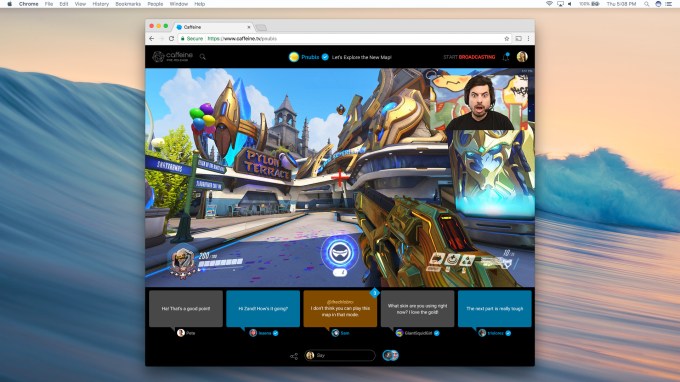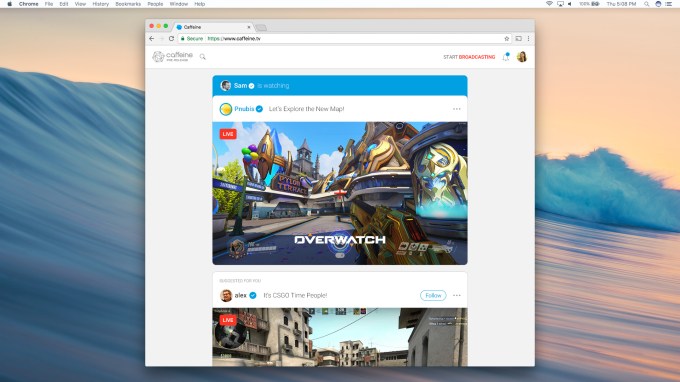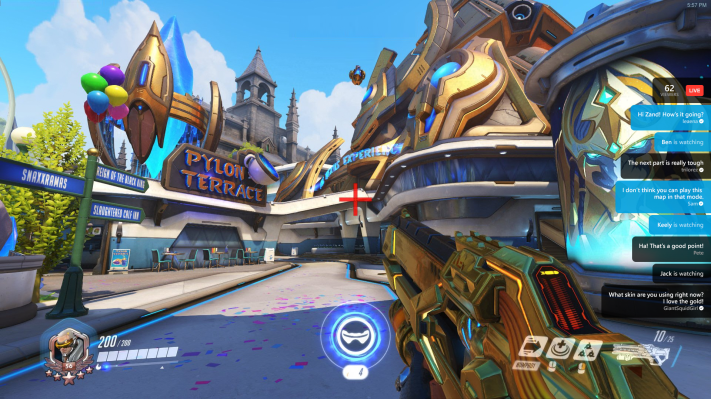A team of ex-Apple engineers and execs is taking on Amazon-owned Twitch and Google’s YouTube Gaming with today’s official launch of a new social broadcasting platform, Caffeine. Backed by $46 million from Andreessen Horowitz and Greylock Partners, Caffeine was co-founded by former Product Design Lead for Apple TV and Chomp co-founder Ben Keighran, along with Senior User Experience Designer at Apple, Sam Roberts.
Keighran joined Apple when he sold his search startup Chomp to the company back in 2012, where it became the basis for an App Store redesign. He later spent several years working on the look-and-feel for the Apple TV, before leaving Apple in 2016 to start his own company.
Roberts, meanwhile, spent six years leading user interface and user experience design on photo, video and TV products at Apple, before leaving to build Caffeine.
Of course, it’s no small matter to take on incumbents like Twitch and YouTube, and to a lesser extent, Twitter’s Periscope, Facebook Live, and Microsoft’s Mixer. You can’t simply build yet another live streaming service and hope for the best – you have to create something original and differentiated.
For Caffeine, that’s a suite of technology products and new experiences that existing rivals don’t have.
For starters, Caffeine has developed its own publication tool, in the form of a free 10 MB download, that makes getting started with streaming easier for the casual gamer.

“There’s about 800 million gamers out there, but there’s roughly 2 million content creators a month on Twitch. We think a lot of people would like to create a broadcast of their video game, but it’s a bit of a pain to do right now,” explains Keighran. “You’ve got to download third-party software; you have to set bitrates, IP addresses, stream keys. You have to have an elaborate set-up with potentially multiple screens,” he says.
With the Caffeine software, gamers can start streaming from their Windows PC with a single click.
In addition to the PC software, users can also live stream their vlog-type content from their web browser or their iPhone.
What’s more, they don’t need a multi-monitor setup because of how Caffeine incorporates viewers’ comments into the experience.
Caffeine has developed custom technology that can detect when a game launches on the PC (by watching the system’s processes), then is able to use the Windows DLL file to inject viewers’ comments as an overlay onto the game itself.
That means your game and your viewers’ comments are all in the same window on your screen.
Finally, and perhaps most notably, is what’s under the hood of Caffeine.
The company built out its own real-time distribution video network that leverages WebRTC – the same technology that powers things like Google Hangouts and other peer-to-peer communications. That means everything on Caffeine is taking place in real-time with zero delays.
[gallery ids="1592672,1592673,1592678"]
Hard-core game streamers may not actually want real-time streams, though, because of the threat of screen sniping. (That’s when someone watches your live stream in order to kill you or taunt you.) But for now, at least, Caffeine isn’t focusing on those top game streamers – it wants to build a service for everyone else.
That said, being able to delay the stream is something Caffeine could add in the future, when it launches the monetization tools that may attract more serious players. That’s not expected until sometime later this year, we’re told.
Beyond all the tools and technology, Caffeine’s user experience is different from what you’d find on other game streaming sites.
“Unlike Twitch and YouTube, we have a people-centric model where we’re more like a social network,” says Keighran. On Caffeine, users follow other people, like friends from Facebook or Twitter or other streamers they like, he explains. “This creates a much more personal experience,” Keighran notes.
In the main feed, you’re then shown live videos from those you follow alongside other human-curated suggestions.

The social elements come into play when you watching a stream, too.
For example, comments from your friends are prioritized in your view, as are those that are “endorsed” (basically, upvoted) by the community.
This ability to filter out the better comments helps streamers too – even if the numbers of viewers gets really big, they’ll be able to see those comments worth answering more easily.
The comments themselves aren’t displayed in a traditional chat-like interface, either, but load in customizable bubbles beneath the chat. You can choose the comment bubble’s background, color scheme, pattern and shape to give it a unique look. (Unfortunately, the option to add a GIF is getting pulled, as a means of protecting streamers against harassment. Apparently, GIFs can be used for evil, too.)
Building a more friendly community is part of Caffeine’s larger focus, as it aims to take on the existing game streaming sites.
“There’s sometimes a toxic community that comes from the fact that if you put everybody in a stream on Twitch – and there are 2,000 people all just anonymously talking over top of each other, says Keighran.
“There’s no surprise that chaos is going to reign, The best experience needs to be simple, friendly, and welcome to a diverse audience,” he adds.
[gallery ids="1592676,1592675"]
To this end, Caffeine brought on former Valve and Oculus executive, Anna Sweet, to head its business, content and strategy efforts. Other members on its team of over 20 (and under 50…the company wouldn’t say exactly) hail from Apple, Netflix, Amazon and Oracle.
Caffeine has been quietly live for some time, but is only officially announcing its plans and fundraising today. The first round closed in 2016 and was led by Greylock; Andreessen Horowitz led the round that closed in February 2017. Ben Horowitz from Andreessen Horowitz and John Lilly from Greylock Partners are on Caffeine’s board of directors as a result.
